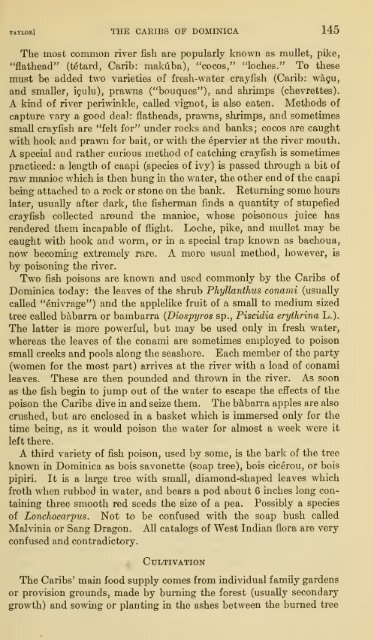You also want an ePaper? Increase the reach of your titles
YUMPU automatically turns print PDFs into web optimized ePapers that Google loves.
TAYLOR) THE CARIBS OF DOMINICA 145<br />
<strong>The</strong> most common river fish<br />
are popularly known as mullet, pike,<br />
"flathead" (tetard, Carib: makiiba), "cocos," "loches." To these<br />
must be added two varieties <strong>of</strong> fresh-water crayfish (Carib: wagu,<br />
and smaller, igulu), prawns ("bouques"), and shrimps (chevrettes).<br />
A kiad <strong>of</strong> river periwinkle, called vignot, is also eaten. Methods <strong>of</strong><br />
capture vary a good deal: flatheads, prawns, shrimps, and sometimes<br />
small crayfish are "felt for" under rocks and banks; cocos are caught<br />
with hook and prawn for bait, or with the epervier at the river mouth.<br />
A special and rather curious method <strong>of</strong> catching crayfish is sometimes<br />
practiced: a length <strong>of</strong> caapi (species <strong>of</strong> ivy) is passed through a bit <strong>of</strong><br />
raw manioc which is then hung in the water, the other end <strong>of</strong> the caapi<br />
being attached to a rock or stone on the bank. Returning some hours<br />
later, usually after dark, the fisherman finds a quantity <strong>of</strong> stupefied<br />
crayfish collected around the manioc, whose poisonous juice has<br />
rendered them incapable <strong>of</strong> flight. Loche, pilve, and mullet may be<br />
caught with hook and worm, or in a special trap known as bachoua,<br />
now becoming extremely rare. A more usual method, however, is<br />
by poisoning the river.<br />
Two fish poisons are known and used commonly by the <strong>Caribs</strong> <strong>of</strong><br />
<strong>Dominica</strong> today: the leaves <strong>of</strong> the shrub Phyllanthus conami (usually<br />
called "enivrage") and the applelike fruit <strong>of</strong> a small to medium sized<br />
tree called babarra or bambarra {Diospyros sp., Piscidia erythrina L.).<br />
<strong>The</strong> latter is more powerful, but may be used only in fresh water,<br />
whereas the leaves <strong>of</strong> the conami are sometimes employed to poison<br />
small creeks and pools along the seashore. Each member <strong>of</strong> the party<br />
(women for the most part) arrives at the river with a load <strong>of</strong> conami<br />
leaves. <strong>The</strong>se are then pounded and thrown in the river. As soon<br />
as the fish begin to jump out <strong>of</strong> the water to escape the effects <strong>of</strong> the<br />
poison the <strong>Caribs</strong> dive in and seize them. <strong>The</strong> babarra apples are also<br />
crushed, but are enclosed in a basket which is immersed only for the<br />
time being, as it would poison the water for almost a week were it<br />
left there.<br />
A third variety <strong>of</strong> fish poison, used by some, is the bark <strong>of</strong> the tree<br />
known in <strong>Dominica</strong> as bois savonette (soap tree), bois cicerou, or bois<br />
pipiri. It is a large tree with small, diamond-shaped leaves which<br />
froth when rubbed in water, and bears a pod about 6 inches long containing<br />
three smooth red seeds the size <strong>of</strong> a pea.<br />
Possibly a species<br />
<strong>of</strong> Lonchocarpus. Not to be confused with the soap bush called<br />
Malvinia or Sang Dragon. All catalogs <strong>of</strong> West Indian flora are very<br />
confused and contradictory.<br />
Cultivation<br />
<strong>The</strong> <strong>Caribs</strong>' main food supply comes from individual family gardens<br />
or provision grounds, made by burning the forest (usually secondary<br />
growth) and sowing or planting in the ashes between the burned tree

















